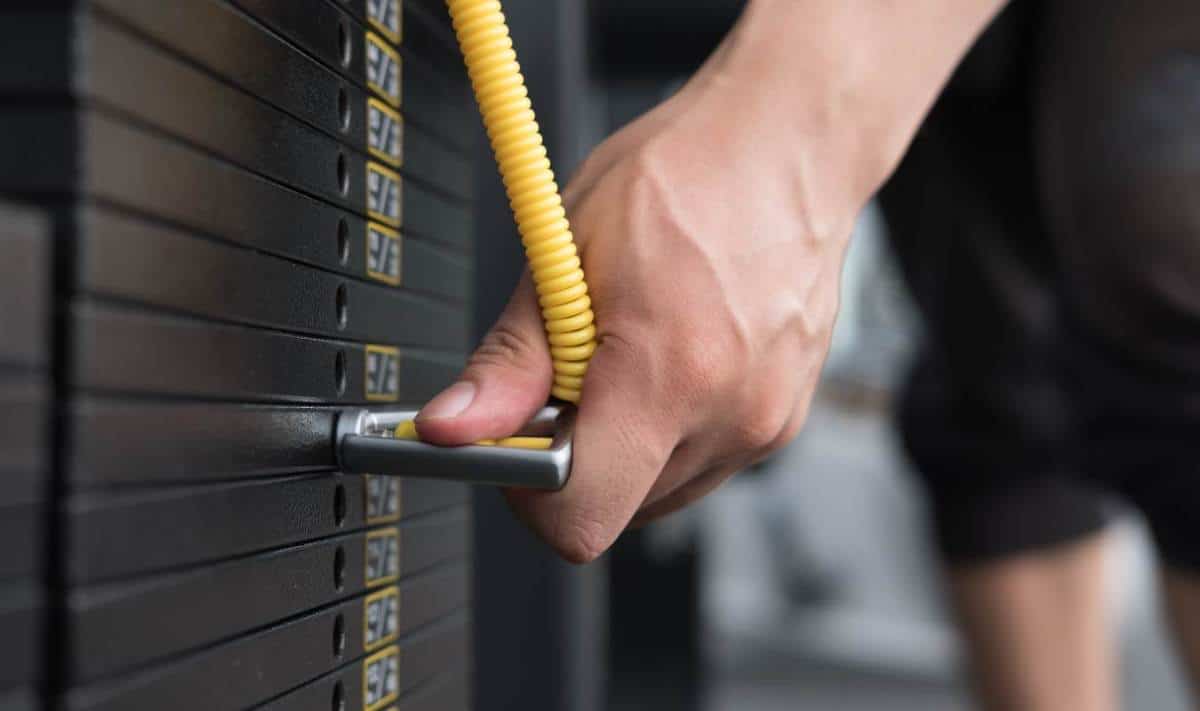
The best online fitness resource you'll ever need. We filter out the BS to ensure you meet your health and fitness goals!

The best online fitness resource you'll ever need. We filter out the BS to ensure you meet your health and fitness goals!

Welcome to the Ultimate Two Body Parts a Day Workout Plan! We combine a 3 Day Push Pull Leg and a Bro Split routine to not only give you a workout plan that hits two muscle groups a day, but also to ensure balanced development, prevent overtraining, and maximize muscle growth and recovery.
This approach blends the structured focus of targeting specific muscle groups in each session, as seen in a Bro Split, with the functional and compound movements of the Push Pull Leg routine.
Training two major muscle groups a day allows for lots of intensity and adequate rest. It also takes advantage of some cool biomechanical realities that set the stage for muscle gains. Things like reciprocal inhibition.
Jump to the workout plan now!
Alternatively, you can download the free PDF version of the routine using the link below:
Get ready to work hard, have fun, and grow.
| Program style | Resistance training with gym machines |
| Workout duration | 1-2 hours |
| Scheduling | 3 days a week |
| Goal | Build muscle |
| Level | Beginners to advanced |
| Target Gender | Male and Female |
You’ll be working out 3 days a week.
Expect to be surprised how hard a 3 day workout plan can be, and how much progress you’ll make if you follow it as-written.
Somewhere in the early 2000s, the fitness industry lost its mind and began preaching a more-is-better-and-all-the-time-is-even-better-than-that workout method.
This stuff makes for interesting T-shirt sloganeering but crappy results… unless of course your goal is just to spend all your time in the gym, be exhausted 24-7 and stand in front of the mirror wondering why you look the same this month as you did 6 months ago.
With this routine, you can expect to begin to truly enjoy the gym, savor each workout, and be surprised by how much you’ll grow and the new shape your muscles will take on.
There are 3 workout days, organized similarly to a traditional Push Pull Legs split.
Shoulder muscles are segregated according to the 3 divisions of the deltoids. Anterior and middle delts are trained on Chest Day. Pecs–obviously–appear on Chest Day.
You’ll train arms on Leg Day and posterior deltoids on Back Day. Your posterior delts participate in all rowing motions, so placing them in a workout along with lats and traps makes sense.
| Day | Split |
|---|---|
| Chest & Deltoids | Chest, Anterior and Middle Deltoids |
| Legs & Arms | Quads, Hams, Glutes, Calves, Biceps, Triceps |
| Back & Posterior Deltoids | Lats, Traps (all divisions), Posterior Deltoids, Spinus Erectors, Rhomboids |
This is the old school classic Monday-Wednesday-Friday (or Tuesday-Thursday-Saturday) split made popular in the 70s by Joe Weider. I started off this way. It’s great for newbs and experienced lifters alike.
If you’d like to add some ab work, add 4 sets of crunches for 10 to 20 reps on any day you like. If you like the alternating right elbow-left knee left elbow-right knee style crunch, those are good too.
If you’re doing the exercises in the plan as intensely as you should, you’ll get plenty of midsection work simply by bracing the core. Reply in the Comments if you’d like the details why abs aren’t included here.
You might also like: 6 Day Push Pull Legs Workout Routine
Don’t feel obligated to follow the body part split exactly as prescribed.
Change the days if that works better for you based on whatever else you’ve got going on in your life and your weekly routine.
Here’s Option 1, a traditional way to arrange the workout days. It follows the classic Weider Monday-Wednesday-Friday routines of years ago. If you’re training hard, it’s an effective spacing of workouts and rest days.
Option 1:
| Weekday | Day | Split |
|---|---|---|
| Sunday | Chest & Deltoids | Chest, Anterior and Middle Deltoids |
| Monday | Rest | |
| Tuesday | Legs & Arms | Quads, Hams, Glutes, Calves, Biceps, Triceps |
| Wednesday | Rest | |
| Thursday | Back & Posterior Deltoids | Back, Posterior shoulders |
| Friday | Rest | |
| Saturday | Rest |
Now here’s Option 2, a rest day spacing that allows for a second recovery day after a monster leg day. Leg days done right take a lot out of you, and a second rest day before heading back to the gym…not a bad idea at all.
Option 2:
| Weekday | Day | Split |
|---|---|---|
| Sunday | Chest & Deltoids | Chest, Anterior and Middle Deltoids |
| Monday | Rest | |
| Tuesday | Legs & Arms | Quads, Hams, Glutes, Calves, Biceps, Triceps |
| Wednesday | Rest | |
| Thursday | Rest | |
| Friday | Back & Posterior Deltoids | Back, Posterior shoulders |
| Saturday | Rest |
And here’s Option 3, for people like me who just can’t wait for Back Day. Back Day is my favorite, and I often push the boundaries of overtraining on Back Day.
This arrangement gives your deltoids more recovery time before you involve the other two delt divisions again on Chest-Deltoid Day, then another two rest days before you hit them again. Again, not a bad idea.
Option 3:
| Weekday | Day | Split |
|---|---|---|
| Sunday | Back & Posterior Deltoids | Back, Posterior shoulders |
| Monday | Rest | |
| Tuesday | Legs & Arms | Quads, Hams, Glutes, Calves, Biceps, Triceps |
| Wednesday | Rest | |
| Thursday | Chest & Deltoids | Chest, Anterior and Middle Deltoids |
| Friday | Rest | |
| Saturday | Rest |
Here is the workout plan using a traditional rest day schedule:
| Exercise | Set 1 | Set 2 | Set 3 | Set 4 |
|---|---|---|---|---|
| Chest Press | 15-20 | 10-12 | 8-10 | 8-10 |
| High Incline Press | 15-20 | 10-12 | 8-10 | 8-10 |
| Chest Flyes | 15-20 | 10-12 | 8-10 | 8-10 |
| Pullovers | 15-20 | 10-12 | 8-10 | 8-10 |
| Lateral Raises | 15-20 | 10-12 | 8-10 | 8-10 |
| Front Raises | 15-20 | 10-12 | 8-10 | 8-10 |
| Exercise | Set 1 | Set 2 | Set 3 | Set 4 |
|---|---|---|---|---|
| Squats | 15-20 | 10-12 | 8-10 | 8-10 |
| Leg Extensions | 15-20 | 10-12 | 8-10 | 8-10 |
| Hip Adductions | 10-12 | 10-12 | 8-10 | 8-10 |
| Romanian Deadlifts (RDLs) OR Single-Leg B-Stance RDLs | 15-20 | 10-12 | 8-10 | 8-10 |
| Leg Curls | 15-20 | 10-15 | 10-12 | 8-10 |
| Calf Raises | 15-20 | 15-20 | 15-20 | |
| Triceps Extensions (Equipment of Choice) | 15-20 | 10-12 | 8-10 | 8-10 |
| Hammer Curls | 15-20 | 10-12 | 8-10 | 8-10 |
| Biceps Curls (Standing or Seated) | 15-20 | 10-12 | 8-10 | 8-10 |
| Exercise | Set 1 | Set 2 | Set 3 | Set 4 |
|---|---|---|---|---|
| Lat Pulldowns | 15-20 | 10-12 | 8-10 | 8-10 |
| Seated Row | 15-20 | 10-12 | 8-10 | 8-10 |
| Posterior Shoulder Flyes | 15-20 | 10-12 | 8-10 | 8-10 |
| “Y” or “I” Raises | 15-20 | 10-12 | 8-10 | 8-10 |
| Kelso Shrugs | 15-20 | 10-12 | 8-10 | 8-10 |

Progressive overload is a constant principle in resistance training. Universally applicable. Application of progressive overload is what separates “training” from just “exercise”.
Progressive overload is adaptive stress applied to exercise.
If the last reps of any set are easy, raise the weight. If they’re too hard or you can’t finish the set, lower the weight.
If every set is pretty easy, no matter how many you do, gains are a wish.
Remember that weights are your tool for muscle growth. Your muscles can’t read the numbers on the weights, and your ego can’t make your guns grow.
Think: I’m going to the gym to accomplish something, not prove something.

Best application for this program is zero reps in reserve for all working sets. Sets 3 and 4 should be all-out.
The last rep of every set should be the last one you can do with good form.
Increase the weight to make the final reps challenging if you can do the last rep of any set with complete ease.
If you sense your body is flirting with overtraining, back off a little by leaving 1 to 2 RIR in all your sets for a couple of weeks’ worth of workouts. It’s much better to undertrain than overtrain.
Symptoms of overtraining include:
Rhythm is key. Smooth, steady, with a squeeze in the contracted position. Think about “flexing” the weights up.
Under no circumstances use momentum of any kind. In this routine, you’re not going for personal best lifts. The numbers on the weights don’t matter. It’s all about what your muscles experience.

Don’t feel obligated to follow the body part split exactly as prescribed above with the 3 examples.
Change the days if that works better for you based on whatever else you’ve got going on in your life and your weekly routine.
Nothing says you can’t create your own workout-rest day schedule. Remember that recovery is half of building muscle, the other half being quality workouts.
Just arrange your workouts and rest days to give your muscles time to rebound. I would not put Chest and Back days on consecutive days; the deltoids get work in both.
Do what you need to do and be smart.
For suggested reading, I cite these references on rest and recovery from the clinical literature:
Level of fitness, your training focus, life stressors, diet, and amount of sleep all influence how you organize your rest days.
Aim for 3 minutes of rest between your “working” sets, where you’re taking each set to the point when your form begins to break down (aka mechanical failure).
Use your rest time productively. Be your own toughest critic. Analyze:
Then, visualize your next set. Perform it in your head.
If you’re fortunate enough to train with someone more experienced than you, use your rest time to ask for feedback.
Champion bodybuilders from the golden years – Arnold, Franco, and their contemporaries – did that all the time. Check out the documentary “Pumping Iron” for examples and some fun watching in general. A must-watch for any serious musclehead.
Download our Two Body Parts a Day Workout Plan PDF below:
We write custom programs. If you have specific physique goals–such as “I’d like wider shoulders”, or “I’d like more ‘V’ in my back”–we can write one for you. Reply in the Comments or simply contact us and we’ll get back in touch. First come, first served.